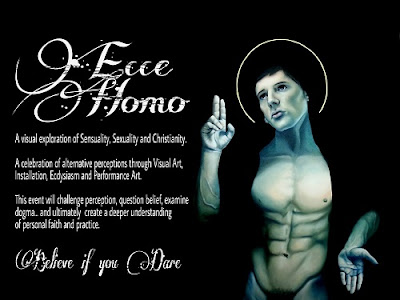Detail from “The Wedding of Jesus and John 'the Beloved Disciple' at Cana” by Christopher Olwage
A wedding between Jesus and his beloved disciple is one of the LGBT Christian themes explored in new paintings and performance art by gay New Zealand artist Christopher Olwage.
The artist's stated goal was not to challenge Christian faith, but to get people to think about it more deeply by considering questions such as these: “What if Christ were gay? What if the Virgin Mary was not a virgin? What if Christ had a long-time lover in John the Apostle or even Lazarus whom he raised from the dead? How different would the world be? How different would you be?”
On opening night Olwage did a dance titled “The Passion of Saint Francis” as part of the exhibit, which was hosted by Auckland’s Lot 23 Gallery in August 2015. Other paintings included a self-portrait as Saint Sebastian, who is often known as the patron saint of gay men.
“Self Portrait as Saint Sebastian” by Christopher Olwage
Olwage is an LGBTQ activist and gender-bending ballet dancer who reigned as Mr. Gay World in 2013. His “Ecce Homo” show included monumental homoerotic paintings of Jesus and his male companions and a self-portrait as Sebastian, who is often called the patron saint of gay men.
In one of the most unusual and accessible paintings, he gives a sacred gay interpretation to the wedding feast at Cana. Jesus performed his first miracle at Cana by turning water into wine. The Bible tells the story in John 2:1-11 without ever naming who was getting married.
“The Wedding of Jesus and John 'the Beloved Disciple' at Cana” by Christopher Olwage
Olwage gives flesh to a long-standing but little-known tradition that Jesus and his beloved disciple John were the bridal couple at the Cana wedding feast. The idea is expressed in the second-century apocryphal Acts of John, where Jesus intervenes three times to prevent John from marrying a woman. Eventually John “binds himself” to Jesus “who didst make my joining unto thee perfect and unbroken.” The idea that John and Jesus married at Cana continued in medieval Europe and is re-affirmed in contemporary times by British theologian Gerard Loughlin in his introduction to the book “Queer Theology: Rethinking the Western Body.”
In Olwage’s painting, John caresses and kisses a hunky Jesus as their halos merge in the midst of an all-male gathering of servants and wedding guests. Among them stand the six stone jars holding the water that Christ transforms into the best wine. The handsome men look spiritually aware and ready to celebrate the miracle of love with their bodies and souls.
A group of men surround Jesus in Olwage’s “Crucifixion,” which appeared in the Auckland show and was featured previously on the Jesus in Love Blog. All are figures that Bible scholars believe may have had male-male sexual relationships: John, Lazarus and the Centurion and his servant.
Christopher Olwage dances in “The Passion of St. Francis”
Olwage incorporated his "Ecce Homo" painting into his dramatic vision of the Passion of Saint Francis of Assisi during his opening-night dance He put the action into words for the Jesus in Love Blog:
“I wanted to depict St Francis' mindscape as he journeyed to Mount La Verna, how he was overcome with immense Joy and Suffering at the sight of the six-winged Seraphim and how the stigmata appeared amidst the vision.
In the entrance to the performance I wore a Franciscan habit, and carried a small wooden box with a scourge in it. I'm not sure if St Francis scourged himself but I wanted to set the scene of total bodily repudiation in search of the ultimate love in Christ, a love so consuming that it bordered on the erotic. Whilst the flagellating occurs, blood began to appear on my back as the welts begin to take form (this was fake blood of course) and I became quite frighteningly elated.
From within this moment and from my mouth I began to pull a rainbow flag... a sign of love, a sign of suffering. My love for Christ was as for a lover. In the throes of my agony and ecstasy, I began to derobe myself, freeing myself of my earthly bonds and baring my flesh, and then the bandages began to seep with blood as the blood from my stigmata began to flow. My final pose saw me reaching to the Picture of Christ as if it were myeverything, recognizing my lover, contemplating our union... the lights faded and I exited stage right.”
Poster for “Ecce Homo” event by Christopher Olwage
___Related links:
Water into Wine: Jesus's Gay Wedding at Cana (Queer Spirituality Blog)





No comments:
Post a Comment